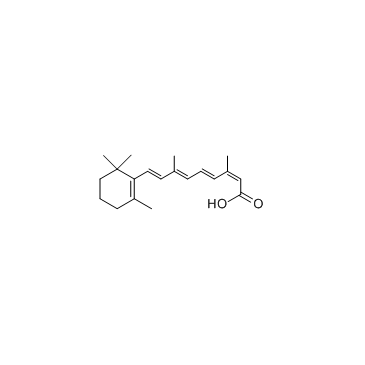异维A酸

异维A酸结构式

|
常用名 | 异维A酸 | 英文名 | Isotretinoin |
|---|---|---|---|---|
| CAS号 | 4759-48-2 | 分子量 | 300.435 | |
| 密度 | 1.0±0.1 g/cm3 | 沸点 | 462.8±14.0 °C at 760 mmHg | |
| 分子式 | C20H28O2 | 熔点 | 172-175 °C(lit.) | |
| MSDS | 中文版 美版 | 闪点 | 350.6±11.0 °C | |
| 符号 |


GHS07, GHS08 |
信号词 | Danger |
|
Cheminformatics analysis of assertions mined from literature that describe drug-induced liver injury in different species.
Chem. Res. Toxicol. 23 , 171-83, (2010) Drug-induced liver injury is one of the main causes of drug attrition. The ability to predict the liver effects of drug candidates from their chemical structures is critical to help guide experimental drug discovery projects toward safer medicines. In this st... |
|
|
Translating clinical findings into knowledge in drug safety evaluation--drug induced liver injury prediction system (DILIps).
J. Sci. Ind. Res. 65(10) , 808, (2006) Drug-induced liver injury (DILI) is a significant concern in drug development due to the poor concordance between preclinical and clinical findings of liver toxicity. We hypothesized that the DILI types (hepatotoxic side effects) seen in the clinic can be tra... |
|
|
Developing structure-activity relationships for the prediction of hepatotoxicity.
Chem. Res. Toxicol. 23 , 1215-22, (2010) Drug-induced liver injury is a major issue of concern and has led to the withdrawal of a significant number of marketed drugs. An understanding of structure-activity relationships (SARs) of chemicals can make a significant contribution to the identification o... |
|
|
A predictive ligand-based Bayesian model for human drug-induced liver injury.
Drug Metab. Dispos. 38 , 2302-8, (2010) Drug-induced liver injury (DILI) is one of the most important reasons for drug development failure at both preapproval and postapproval stages. There has been increased interest in developing predictive in vivo, in vitro, and in silico models to identify comp... |
|
|
Chemical genetics reveals a complex functional ground state of neural stem cells.
Nat. Chem. Biol. 3(5) , 268-273, (2007) The identification of self-renewing and multipotent neural stem cells (NSCs) in the mammalian brain holds promise for the treatment of neurological diseases and has yielded new insight into brain cancer. However, the complete repertoire of signaling pathways ... |
|
|
Genetic mapping of targets mediating differential chemical phenotypes in Plasmodium falciparum.
Nat. Chem. Biol. 5 , 765-71, (2009) Studies of gene function and molecular mechanisms in Plasmodium falciparum are hampered by difficulties in characterizing and measuring phenotypic differences between individual parasites. We screened seven parasite lines for differences in responses to 1,279... |
|
|
FDA-approved drug labeling for the study of drug-induced liver injury.
Drug Discov. Today 16 , 697-703, (2011) Drug-induced liver injury (DILI) is a leading cause of drugs failing during clinical trials and being withdrawn from the market. Comparative analysis of drugs based on their DILI potential is an effective approach to discover key DILI mechanisms and risk fact... |
|
|
Evaluation of the retinoids with cisplatin and vincristine in xenograft models of neuroblastoma.
J. Pediatr. Hematol. Oncol. 36(1) , e23-7, (2013) Retinoids have been studied for the treatment of children with neuroblastoma for >25 years. Posttransplant administration of isotretinoin is standard of care for children with high-risk neuroblastoma, whereas fenretinide remains investigational. Previous prec... |
|
|
Synthesis and characterization of a new retinoic acid ECPIRM as potential chemotherapeutic agent for human cutaneous squamous carcinoma.
Anticancer Agents Med. Chem. 15 , 1204-12, (2015) Cutaneous squamous cell carcinoma (CSCC) is one of the most common cancers worldwide, requiring effective therapeutic interventions. Retinoids are important chemopreventive and therapeutic agents for a variety of human cancers including CSCC. In this study we... |
|
|
Metabolic characteristics of 13-cis-retinoic acid (isotretinoin) and anti-tumour activity of the 13-cis-retinoic acid metabolite 4-oxo-13-cis-retinoic acid in neuroblastoma.
Br. J. Pharmacol. 171(23) , 5330-44, (2014) Isotretinoin (13-cis-retinoic acid; 13-cRA) is a differentiation inducer used to treat minimal residual disease after myeloablative therapy for high-risk neuroblastoma. However, more than 40% of children develop recurrent disease during or after 13-cRA treatm... |